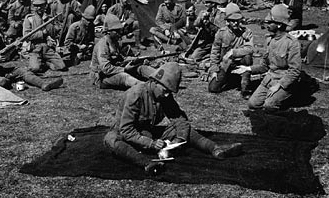Uniforms & Equipment
The Canadian Uniform

Canadian military dress in South Africa was very similar to that used by the British Army. The experience of colonial wars in the nineteenth century convinced the British to abandon red coats for their soldiers and adopt khaki-coloured clothing, which helped the troops blend in with the landscape. The word “khaki” is believed to derive from the Hindi word for dust, and it was in India that British troops first wore the colour as regulation dress.
When Canada offered a contingent for service in South Africa in October 1899, there were no stocks of khaki uniforms available, and they had to be manufactured in a matter of weeks. W.E. Sandford Manufacturing Company of Hamilton, Ontario, undertook this task. Since there were no supplies of the standard strong but pliable British military fabric available, however, the company made the Canadian uniforms from canvas.
The Canadian coat was different from the British in that it had a stand collar which fastened shut, and it also fitted slightly closer to the body than the British. Like the British, however, the Canadian coat had two pleated breast pockets, and an integral strap on each shoulder. The trousers were also of canvas, and had a button fly and suspender buttons.
Although this uniform was as durable as those of British military fabric, the canvas proved stiff and harsh, chaffing the necks and legs of the troops. Moreover, the dye used to colour the garments washed away, and they quickly faded to an off-white. Canadians therefore received uniforms from British stocks as soon as they could be made available.
The 2nd (Special Service) Battalion, Royal Canadian Regiment of Infantry wore the British 1898-pattern cork helmet, which was already used in Canada by the North-West Mounted Police. It was a popular form of headdress in tropical climates. When first issued, these helmets were coloured white and the men attempted to dye them with coffee on shipboard. Shortly after their arrival in Cape Town, however, they were issued with khaki covers instead. The officers and men of all subsequent contingents were issued with the broad-brimmed felt Stetson hat, which probably became the most readily identifiable Canadian trademark of the war.
The footwear of Canadian troops in South Africa was for the most part similar to that of their British counterparts: black leather ankle boots and khaki woolen puttees. The boots were of lighter construction than the British, but were of better quality and durability. The bandage-like puttees were wrapped around the lower leg overlapping the top of the boot, to provide support to the ankle and also to prevent dirt and stones from entering the boot. Ankle boots and puttees were worn by infantry, artillery and mounted rifle units. Officers in the mounted rifles and artillery also wore the formed leather "Stohwasser" leggings. Although they too were issued with ankle boots and puttees, both officers and men of Strathcona's Horse wore specially issued high brown-leather riding boots, called Strathcona boots, as much as possible.
As insignia, the members of the 2nd (Special Service) Battalion, Royal Canadian Regiment of Infantry wore a maple-leaf badge surmounted by the imperial crown and bearing the word "Canada" on the left side of their cork helmets. Two smaller versions were also worn on the collar. The Royal Canadian Dragoons, Canadian Mounted Rifles, and Royal Canadian Field Artillery wore the maple-leaf badge on their headdress, but had brass letters at the base of their shoulder epaulette to indicate the unit. The insignia for Strathcona's Horse consisted of a shield-shaped cap and collar badge and the letters SH in brass on the epaulettes.
